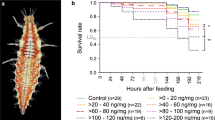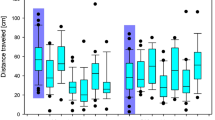The toxicity of soil pesticide residues to target and non-target organisms depends on the amount of chemical absorbed by the organism. One of the principle factors governing chemical uptake is the amount of chemical encountered by the animal and, hence, the area of soil contacted. This in turn, depends on the locomotor behaviour of the animal. In the present study, the relationship between the uptake of soil residues of an organophosphate insecticide and locomotor behaviour was examined, employing 14C-labelled dimethoate and computer-aided video tracking. Groups of male woodlice, Porcellio scaber (Isopoda), walked freely for 22 h on a soil substrate treated with three application rates of the pesticide. A strong correlation was found between pesticide uptake and path length, mean velocity and time spent in locomotor acivity, which is consistent with previously reported modelling studies. Our data suggest a linear relationship for all locomotor parameters except for path length at the highest application rate, where uptake was best described by an inverse exponential relationship. All doses induced hyperactivity in terms of time spent in locomotor activity. However, when compared with a untreated control group, the most pronounced effects were displayed at the lowest dose where path length, mean velocity and turning rate were also significantly different. The number of shifts between locomotor active and inactive periods in the experimental period increased with increasing application rate.
Similar content being viewed by others
References
Baatrup E. and Bayley M. (1993a) Quantitative analysis of spider locomotion employing computer-automated video tracking. Physiol. Behav. 54, 83–90.
Baatrup E. and Bayley M. (1993b) Effects of the pyrethroid insecticide Cypermethrin on the locomotor activity of the wolf spider Pardosa amentata: quantitative analysis employing computer-automated video tracking. Ecotoxicol. Environ. Saf. 26, 138–52.
Barker R.J., Lehner Y. and Kunzmann M.R. (1980) Pesticides and honey bees: nectar and pollen contamination in alfalfa treated with dimethoate. Arch. Environ. Contamin. Toxicol. 9, 125–33.
Bayley M. (1995) Prolonged effects of the insecticide dimethoate on locomotor behaviour in the woodlouse, Porcellio scaber Latr. (Isopoda). Ecotoxicol. 4, 1–12.
Bukhari M.A. and Alikhan M.A. (1985) Calorific value and ash content in relation to body length and dry weight of Porcellio spinicornis Say (Isopoda, Porcellionidae). Crustaceana 49, 290–8.
Diem K. and Seldrup J. (1982) Geigy Scientific Tables Vol.II. Introduction to Statistics, Statistical Tables, Mathematical Formulae, eighth edition. Basle: Ciba-Geigy.
Elliot J.M. (1993) Some Methods for the Statistical Analysis of Samples of Benthic Invertebrates, second edition. Ambleside, Cumbria: Freshwater Biological Association.
Frantík E. and Horváth M. (1992) Integration of behavioural and neurophysiological approaches in neurotoxicology. Toxicol. Lett. 64/65, 225–9.
Gray J. (1968) Animal locomotion London: Weidenfeld and Nicolson.
Harris C.R. (1971) Influence of temperature on the biological activity of insecticides in soil. J. Econ. Entomol. 64, 1044–9.
Jagers op Akkerhuis G.A.J.M. and Hamers T.H.M. (1992) Substrate-dependent bioavailability of deltamethrin for the epigeal spider Oedothorax apicatus (Blackwall) (Araneae, Erigonidae). Pestic. Sci. 36, 59–68.
Jepson P.C., Chaudhry A.G., Salt D.W., Ford M.G., Efe E. and Chowdhury A.B.M.N.U. (1990) A reductionist approach towards short-term hazard analysis for terrestrial invertebrates exposed to pesticides. Funct. Ecol. 4, 339–47.
Laurence G.C. (1972) Comparative swimming abilities of fed and starved largemouth bass (Micropterus salmoides). J. Fish Biol. 4, 73–8.
Little E.E. and Finger S.E. (1990) Swimming behavior as an indicator of sublethal toxicity in fish. Environ. Toxicol. Chem. 9, 13–19.
Luckey T.D. (1968) Insect hormoligosis. J. Econ. Entomol. 61, 7–12.
Moosbeckhofer R. (1983) Laboruntersuchungen über den einfluß von diazinon, carbofuran und chlorvinfos auf die laufaktivität von Poecilus cupreus L. (Col., Carabidae). Z. Angew. Ent. 95, 15–21.
Morse J.G. and Zareh N. (1991) Pesticide-induced hormoligosis of citrus thrips (Thysanoptera: Thripidae) fecundity. J. Econ. Entomol. 84, 1169–74.
Parsons P.A. (1989) Acetaldehyde utilization in Drosophila: an example of hormesis. Biol. J. Linn. Soc. 37, 183–9.
Salt D.W. and Ford M.G. (1984) The kinetics of insecticide action. Part III: the use of stochastic modelling to investigate the pick-up of insecticides from ULV-treated surfaces by larvae of Spodoptera littoralis Boisd. Pestic. Sci. 15, 382–410.
Stebbing A.R.D. (1982) Hormesis—the stimulation of growth by low levels of inhibitors. Sci. Tot. Environ. 22, 213–34.
Steel C.G.H. (1982) Stages of the intermoult cycle in the isopod Oniscus asellus and their relation to biphasic cuticle sectretion. Can. J. Zool. 60, 429–37.
Sutton S.L. (1980) Woodlice. Oxford: Pergamon Press.
Walton K.C. (1987) Factors determining amounts of fluoride in woodlice Oniscus asellus and Porcellio scaber, litter and soil near an aluminium reduction plant. Environ. Pollut. 46, 1–9.
Wiles J.A. and Jepson P.C. (1993) An index of the intrinsic susceptibility of non-target invertebrates to residual deposits of pesticides. In Eijsackers H., Heimbach F. and Donker M. eds. Ecotoxicology of soil organisms pp 287–302. Chelsea, USA: Lewis Publishers.
Author information
Authors and Affiliations
Rights and permissions
About this article
Cite this article
Bayley, M., Baatrup, E. Pesticide uptake and locomotor behaviour in the woodlouse: an experimental study employing video tracking and 14C-labelling. Ecotoxicology 5, 35–45 (1996). https://doi.org/10.1007/BF00116322
Issue Date:
DOI: https://doi.org/10.1007/BF00116322




